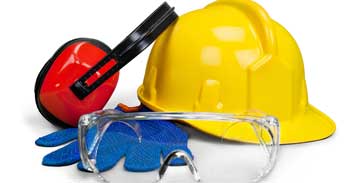
Let’s talk safety.
In any environment of personal life or the workplace, everyone wants to feel protected. Whether you are a doctor, chef in a restaurant kitchen, first responder or working on a construction site as a craft professional, you must ask the most important question – Am I safe?
With so many misconceptions of construction, one of the most common is that it is dangerous, when in fact there are numerous safety protocols and procedures that companies follow. Construction is safer than you might think, and each year the industry refocuses, re-energizes and finds new ways to promote the importance of safety.
Much of this focus is on the necessary fashion of personal protective equipment, or PPE for short. Used in a variety of industries, but essential to the protection of craft professionals in the field, PPE has helped construction work toward one goal: everyone going home safely at the end of the night.
As craft professionals wear this equipment each day, look at how construction PPE is shaping the industry and shifting the perceptions of safety in the workplace.
According to the Occupational Safety and Health Administration (OSHA), personal protective equipment (PPE) is used or worn by workers to minimize the dangers in the workplace. Highly recommended to protect workers, craft professionals can complete projects and avoid risks that may cause injury or illness from contact with “chemical, radiological, physical, electrical, mechanical or other workplace hazards.”
Personal protective equipment is more than just a hard hat; it’s full body coverage. Making the workplace safer, the large array of construction PPE can protect the wearer from potential health and safety hazards when performing daily tasks.

With a collection of wearable equipment and gear, OSHA breaks PPE into five major categories: eye and face protection, foot protection, hand protection, head protection and hearing protection.
From sparks to falling debris, most impact injuries are caused by these tiny specs when it strikes the eye. When working in the construction field, workers need to take the necessary precautions to avoid punctures or abrasions from flying objects and wear primary and/or secondary protective devices. Equipment to protect against impact hazards include safety spectacles, safety goggles and face shields.
If a craft professional’s work involves transporting massive material, lifting heavy equipment or carrying objects to a specific location, protective footwear should be worn. Wearing safety work shoes or boots with slip-resistant and puncture-resistant soles will protect the worker’s foot from elements inside the construction site.
Safety gloves are primarily used for hand protection and it is important to make sure the right gloves are used for the job. Craft professionals work with a variety of different materials to complete projects and specialty gloves can be used for concrete work, welding or jobs that expose the worker to electrical hazards.
Bumps, bruises and head injuries can result from objects falling from above, fixed objects or contact with electrical hazards. With potential exposure to these types of risks, craft professionals wear one of the most recognizable pieces of protective equipment, hard hats. Becoming a symbol of the construction industry, hard hats are at the basis of construction PPE.
A construction site can be a loud environment, from cranes lifting heavy objects to power tools working on projects. Workers are exposed to a variety of noises that fall above the normal sound exposure of 70 decibels, which over a prolonged time may cause damage. Using earplugs and earmuffs can help to minimize high noise in work areas and benefit both the craft professional and their job.
Health and safety in the construction industry is a wide concern, but if companies and craft professionals work together, they can work to prevent accidents before they occur.
In fact, in over four decades, OSHA and several organizations, associations, employers and safety advocates have had a dramatic effect on workplace safety. Construction-related deaths are down on average and personal protective equipment plays a huge role in protecting workers.
With equipment readily available, the construction industry can continue to foster a safe environment for craft professionals each day.